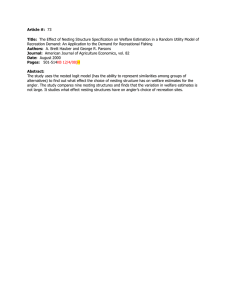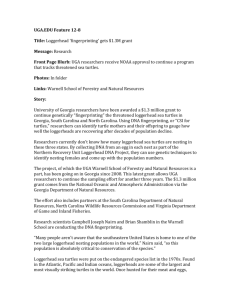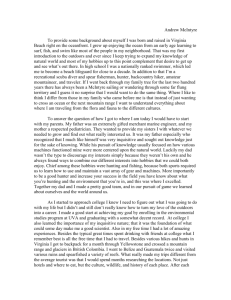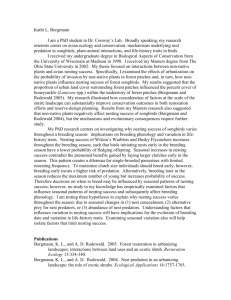oviposited subsequent clutches (without oxytocin
advertisement
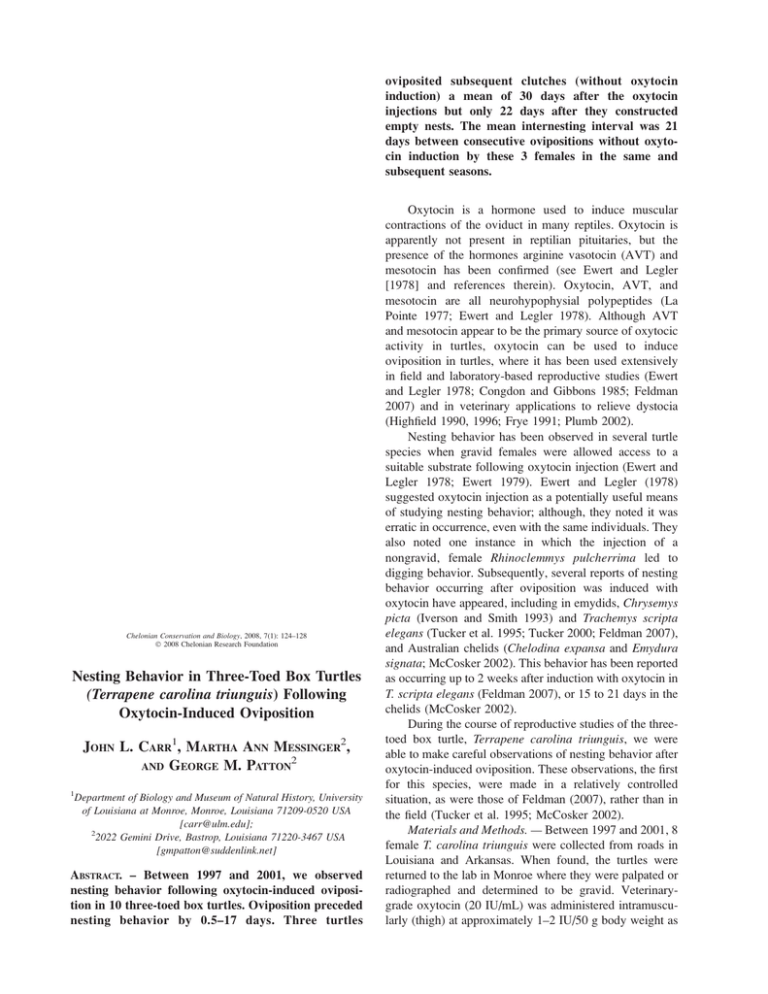
oviposited subsequent clutches (without oxytocin induction) a mean of 30 days after the oxytocin injections but only 22 days after they constructed empty nests. The mean internesting interval was 21 days between consecutive ovipositions without oxytocin induction by these 3 females in the same and subsequent seasons. Chelonian Conservation and Biology, 2008, 7(1): 124–128 Ó 2008 Chelonian Research Foundation Nesting Behavior in Three-Toed Box Turtles (Terrapene carolina triunguis) Following Oxytocin-Induced Oviposition JOHN L. CARR1, MARTHA ANN MESSINGER2, 2 AND GEORGE M. PATTON 1 Department of Biology and Museum of Natural History, University of Louisiana at Monroe, Monroe, Louisiana 71209-0520 USA [carr@ulm.edu]; 2 2022 Gemini Drive, Bastrop, Louisiana 71220-3467 USA [gmpatton@suddenlink.net] ABSTRACT. – Between 1997 and 2001, we observed nesting behavior following oxytocin-induced oviposition in 10 three-toed box turtles. Oviposition preceded nesting behavior by 0.5–17 days. Three turtles Oxytocin is a hormone used to induce muscular contractions of the oviduct in many reptiles. Oxytocin is apparently not present in reptilian pituitaries, but the presence of the hormones arginine vasotocin (AVT) and mesotocin has been confirmed (see Ewert and Legler [1978] and references therein). Oxytocin, AVT, and mesotocin are all neurohypophysial polypeptides (La Pointe 1977; Ewert and Legler 1978). Although AVT and mesotocin appear to be the primary source of oxytocic activity in turtles, oxytocin can be used to induce oviposition in turtles, where it has been used extensively in field and laboratory-based reproductive studies (Ewert and Legler 1978; Congdon and Gibbons 1985; Feldman 2007) and in veterinary applications to relieve dystocia (Highfield 1990, 1996; Frye 1991; Plumb 2002). Nesting behavior has been observed in several turtle species when gravid females were allowed access to a suitable substrate following oxytocin injection (Ewert and Legler 1978; Ewert 1979). Ewert and Legler (1978) suggested oxytocin injection as a potentially useful means of studying nesting behavior; although, they noted it was erratic in occurrence, even with the same individuals. They also noted one instance in which the injection of a nongravid, female Rhinoclemmys pulcherrima led to digging behavior. Subsequently, several reports of nesting behavior occurring after oviposition was induced with oxytocin have appeared, including in emydids, Chrysemys picta (Iverson and Smith 1993) and Trachemys scripta elegans (Tucker et al. 1995; Tucker 2000; Feldman 2007), and Australian chelids (Chelodina expansa and Emydura signata; McCosker 2002). This behavior has been reported as occurring up to 2 weeks after induction with oxytocin in T. scripta elegans (Feldman 2007), or 15 to 21 days in the chelids (McCosker 2002). During the course of reproductive studies of the threetoed box turtle, Terrapene carolina triunguis, we were able to make careful observations of nesting behavior after oxytocin-induced oviposition. These observations, the first for this species, were made in a relatively controlled situation, as were those of Feldman (2007), rather than in the field (Tucker et al. 1995; McCosker 2002). Materials and Methods. — Between 1997 and 2001, 8 female T. carolina triunguis were collected from roads in Louisiana and Arkansas. When found, the turtles were returned to the lab in Monroe where they were palpated or radiographed and determined to be gravid. Veterinarygrade oxytocin (20 IU/mL) was administered intramuscularly (thigh) at approximately 1–2 IU/50 g body weight as NOTES AND FIELD REPORTS 125 Table 1. Timing of events related to oxytocin injections and nesting behavior in T. carolina triunguis. Female no. Wild-caught group 1 2 3 4 5 6 7 8 Dystocia group 3 9 10 Injection date Injection time (h) Date moved to study site Date of empty nest construction Time when covering empty nest (h) Elapsed time from injection to covering (h) 10 Jun 1997 18 Jun 1997 3 Jun 1998 13 Jun 1999 30 Apr 2000 25 Jun 2001 18 Jun 2001 10 Jul 2001 1555 0950 1430 1350 1230 1530 1025 1400 12 Jun 22 Jun 5 Jun 16 Jun 4 May 1 Jul 20 Jun 12 Jul 16 Jun 1997 26 Jun 1997 8 Jun 1998 20 Jun 1999 12 May 2000 6 Jul 2001 5 Jul 2001 19 Jul 2001 2200 2330 0130 2130 2300 2300 1930 2300 150.5 206.0 131.0 176.0 295.0 271.5 417.0 225.0 9 Aug 1997 29 Jun 2001 24 Jul 2001 1155 1300 1330 1989 1998 2000 9 Aug 1997 5 Jul 2001 27 Jul 2001 2330 1000 2330 12.0 141.0 75.0 recommended by Ewert and Legler (1978). The time of injection was recorded to the nearest 5 minutes, after which the turtle was placed in a bucket of water on a wire mesh platform, which allowed us to collect the eggs undamaged. Eggs were usually oviposited within 3–4 hours, but occasionally it was necessary to administer a second dose of oxytocin (turtles 1 and 10). After egg laying, females were maintained in the lab in a dry, uncluttered plastic or cardboard container at room temperature. Turtles 1–8 were released at our study site 2–6 days after oxytocin injection. The outdoor study site in Bastrop, Louisiana is a 31 3 34 m semi-natural habitat described in Messinger and Patton (1995). All females at the study site received the same treatment in food, water, and shelter allocation. Handling was kept to a minimum except in case of illness or injury. Turtles were identified by individual head, leg, and shell characteristics. Also, 3 females residing at our Bastrop study site developed dystocia (egg binding), providing the opportunity for additional observations (one of these 3 was also one of the original 8 wild-caught specimens—turtle 3). When we suspected dystocia based on atypical behavior, the turtle was confirmed to be gravid by radiograph and administered oxytocin. The turtle then was returned immediately to the outdoor enclosure where oviposition took place. During the nesting season, we made repeated trips throughout the day, evening, and early hours of darkness looking for signs of nesting. Most nesting takes place beginning in late afternoon and evening, with completion often occurring after dark. When signs of nesting were observed, we made frequent visits to follow its progress. The time when the female was noticed covering the nest was recorded to the nearest 0.5 hour. Because of variation in the duration of nest covering and since the entire nesting sequence was not observed, the time to nest completion may be short by as many as 2 hours. Elapsed time between the oxytocin injection and nest covering was rounded to the nearest half hour; this measure is used as an indication of the degree of dissociation between the time of oviposition and nest construction. Nest sites were marked and excavated later. We excavated nest cavities to ascertain the physical structure of the cavities, and to document the presence of eggs. Dates of subsequent nesting by these same females also were recorded. Results. — Injection with oxytocin lead to oviposition in all 11 cases involving 10 individual females, and this was followed by typical nesting behavior, i.e., oviposition and nesting behavior were not associated. Other than the cases detailed here, nesting behavior and oviposition always occur in association with one another. Data on timing of injection and nesting are found in Table 1. The range of values for elapsed time was from less than one day (12 hours) to more than 17 days (417 hours) (mean ¼ 191 hours [8 days]). For the 8 wild-caught females, the elapsed time between oxytocin injection and nest covering ranged from 131 to 417 hours (mean ¼ 234.5 hours [9.8 days]). This elapsed time includes a mean of 3.1 days spent in the lab before transfer to the study site during which time a suitable nesting substrate was not available. The 3 dystocia-affected turtles (Table 1) had been residents of the study site for at least a year. Although a suitable nesting substrate was available immediately following their oxytocin injection, none of the 3 dystocia-affected females dug a nest in response to oxytocin induction; eggs were deposited on the surface of the ground. The mean elapsed time for these 3 was 76.0 hours (3.2 days) between oxytocin administration and nest covering. The elapsed time was significantly greater for the wild-caught group than the dystocia group (t ¼ 3.011, p ¼ 0.024, df ¼ 6). The nests of all oxytocin-injected females were typical of nests constructed by gravid T. carolina triunguis, including the duration of behaviors and the physical dimensions of the nests. All nests were closed using surface litter and soil from the excavated nest cavity (Messinger and Patton 1995), but there were no eggs in the nest. From the time of their arrival at the study site until after nests were completed, the behavior of the 8 wildcaught females was typical of gravid T. carolina triunguis, 126 CHELONIAN CONSERVATION AND BIOLOGY, Volume 7, Number 1 — 2008 Table 2. Data on internesting intervals for wild-caught female T. carolina triunguis that oviposited a subsequent clutch in the same season as the oxytocin-induced clutch. Female no. 2 4 6 Total Subsequent intervals Date of next oviposition Interval since oxytocininduced oviposition (d) Interval since empty nest construction (d) Mean (d) SD n range (d) 13 Jul 1997 8 Jul 1999 5 Aug 2001 24 25 41 30.0 17 18 30 21.7 19.7 23.0 20.0 20.9 3.2 6.3 4.2 15 5 2 16 –26 18–34 17–23 16 –34 as was that of the 3 dystocia-group females following oxytocin-induced oviposition. There were two other circumstances when dissociation between oviposition and nesting was observed. Turtle 9 excavated and covered a complete nest that had no eggs while she was suffering from dystocia 4 days before she received the oxytocin injection detailed in Table 1. One other female (11) constructed and covered 7 empty nests sequentially over a 2-year period in 1998 and 1999. She was never observed to oviposit a clutch; although, in all other respects, her nesting behavior appeared normal. Nesting interval data for 3 of the wild-caught females that oviposited a subsequent clutch in the same nesting season as the oxytocin-induced oviposition are presented in Table 2. The time between oxytocin-induced oviposition and subsequent oviposition averaged 30.0 days. Internesting intervals calculated from the date of empty nest construction (following the oxytocin-induced oviposition) to the subsequent nesting closely coincided with all subsequent internesting intervals recorded for the 3 individuals (21.7 vs. 20.9 days). Discussion. — Oviposition coinciding with nesting behavior is well established in turtles, except for a few species that oviposit without construction of a nest (Kuchling 1999). The typical behavioral sequence includes nest-site selection, nest-site preparation, egg-cavity construction, oviposition, and nest covering (Ehrenfeld 1979; Kuchling 1999). This behavioral sequence is associated with a complex set of physiological events involving gonadal hormones, neurohypophysial hormones, and peripheral neuronal regulation (Feldman 2007). Sea turtles are known to exhibit consecutive spikes of 2 neurohypophysial hormones, AVT and neurophysin, preceding two prostaglandin peaks (PGF and PGE2) during oviposition (Owens 1997; Kuchling 1999). The generality of this specific series of physiological events with respect to turtle oviposition is not established; although, it seems likely to play a role in the highly stereotypical nesting behavior of chelonians (Ehrenfeld 1979). For sea turtles that oviposit multiple clutches in one season, ovulation of subsequent clutches occurs within approximately 48 hours after nesting and is correlated with surges of luteinizing hormone and progesterone (Licht 1982; Owens 1997). Administration of oxytocin to gravid T. carolina triunguis led to atypical behavior in which oviposition and nesting behaviors were decoupled, a phenomenon termed ‘‘false nesting’’ by Tucker et al. (1995). Rather than coinciding, oviposition preceded nesting behavior by anywhere from 12 to 417 hours, and the elapsed time between these 2 events could be extended by withholding a suitable nesting substrate (i.e., time spent in the lab). These observations are in accord with previous reports for deirochelyine emydids (Iverson and Smith 1993; Tucker et al. 1995; Feldman 2007) and chelids (McCosker 2002), and may indicate a susceptibility of many chelonians after the administration of oxytocin. Tucker et al. (1995) suggested that oxytocin induced the post-ovipositional nesting behavior. We agree with McCosker (2002), however, that this is not likely a cause and effect relationship since the oxytocin concentration in the blood should drop continuously post-injection as it is metabolized by the liver and kidneys (Plumb 2002). In mammals, the half-life of oxytocin is measured in minutes (Plumb 2002), yet we recorded elapsed times between oxytocin injection and nesting behavior in hours and days. The dissociation between oviposition and nesting behavior following oxytocin injection indicates that a complete sequence of nesting behavior is not dependent on the presence of eggs in the oviduct(s), nor the actual oviposition of eggs. Other than the 11 nesting events by 10 individuals reported here, 2 additional sets of observations support this hypothesis (this is out of a total of 1060 nesting events by 79 females over an 11-year period, 1996–2006). In one case, a female with dystocia went through an entire nesting behavioral sequence to produce an empty nest before receiving oxytocin. Another female maintained at the study site for several years appeared physically and behaviorally normal and was never administered oxytocin, yet she was observed on 7 occasions to exhibit a complete set of nesting behaviors that lead to typical nest cavities but without eggs. She did this at regular intervals typical of the interclutch interval for T. carolina triunguis (Messinger and Patton 1995). These observations support the hypothesis of McCosker (2002) and Feldman (2007) that the ‘‘normal nestingrelated hormonal sequence’’ does not occur when oxytocin is administered to obtain eggs, and thus the female returns to the behavioral task of nesting at a later time when that hormonal sequence can play out. Extension of this idea suggests that subsequent clutches in the same nesting season will be delayed by the elapsed time between oxytocin administration and completion of the nesting NOTES AND FIELD REPORTS behavior (the ‘‘false’’ nest), which would account for prolonged internesting intervals mentioned by Iverson and Smith (1993). The mean internesting interval we observed was 21.7 days between empty nest construction and subsequent nesting versus 30.0 days between oxytocin-induced oviposition and subsequent nesting. This compares with a mean internesting interval of 20.9 days for intervals between consecutive nests for these females in the same and subsequent seasons. This mean is near the 19.4-day mean of 105 internesting intervals in T. carolina triunguis (Messinger and Patton 1995), and the 21.3 days of a more recent calculation for 2001 and 2002 internesting intervals (n ¼ 206, Messinger and Patton, pers. obs.). Our data suggest that subsequent clutches in the same season will be delayed until completion of the nesting behavior and its associated hormonal sequence that occurs at some point after the oxytocin-induced oviposition. Thus, ovulation of a subsequent clutch depends on completion of nesting behavior and not oviposition. We found a significant difference between prior residents (dystocia group) and new residents (wild-caught group) at the study site in the time elapsed from oxytocininduced oviposition to nest covering (3.2 vs. 9.8 days). It is possible that stress from the initial handling and unfamiliar environment may suppress reproductive function (Kuchling 1999; Feldman 2007), leading to the longer elapsed times in the new study site residents. Additionally, the period of days post-injection (2– 6) in the lab without access to a nesting substrate may have influenced our results. The use of exogenous oxytocin has proven useful in gathering reproductive data from turtles (Ewert 1985) and to relieve dystocia (Frye 1991; Highfield 1996). Oxytocin differs from AVT in structure by only a single amino acid but is capable of binding to receptors in the oviduct and stimulating smooth muscle contractions that will expel eggs. Oxytocin appears to override the normal sequence of hormonal events related to nesting, and may not enter into the regulatory feedback of the hypothalamic–pituitary– gonadal axis. As a consequence, a turtle in which oviposition has been induced with oxytocin may still undergo a hormonal cascade and associated nesting behavior at a later time in spite of lacking oviductal eggs. Tucker et al. (1995:138) suggested ‘‘that turtles be held at least 24 h post-induction to reduce nesting efforts that expose turtles to unnecessary risk of mortality.’’ Tucker (2000) later held T. scripta elegans for 48 hours after oxytocin-induced oviposition in order to ‘‘prevent’’ nesting behavior. Our findings indicate that in T. carolina triunguis, nesting after oxytocin-induced oviposition may be delayed for a much longer period of up to 17 days. Although taxon-specific differences are possible, the variability we have observed in T. carolina triunguis suggests that a 24- to 48-hour holding period is insufficient (also supported by McCosker [2002] and Feldman [2007]), and it is not clear that it is possible to prevent 127 nesting behavior subsequent to oxytocin-induced oviposition. When oxytocin is used, in order to shorten the period between induced oviposition and nesting, we suggest that females be released back into the environment from which they came as quickly as possible in order to alleviate stress associated with a lab/captive stay and exposure to an unfamiliar environment. Alternatively, we recommend that a suitable nesting substrate be made available if the female is not immediately released. Acknowledgments. — We would like to thank Robert L. White, Tyler Thomas, and Brett Bennett for assistance with radiographs; Melinda Matthews and Joe Peach; Senator Robert H. Barham, without whose help this study could not have been completed; and the Louisiana Department of Wildlife & Fisheries for Scientific Collecting Permits LNHP-96-031, 97-034, 97-050, 98034, 98-069, 99-031, 99-073, 00-35, 00-078, 01-038, 01060, 02-082, 03-033, 04-061, 05-037, and 06-018. We also thank Mark Feldman for comments on the manuscript. LITERATURE CITED CONGDON, J.D. AND GIBBONS, J.W. 1985. Egg components and reproductive characteristics of turtles: relationships to body size. Herpetologica 41:194–205. EHRENFELD, D.W. 1979. Behavior associated with nesting. In: Harless, M. and Morlock, H. (Eds.). Turtles: Perspectives and Research. New York: John Wiley & Sons, pp. 417– 434. EWERT, M.A. 1979. The embryo and its egg: development and natural history. In: Harless, M. and Morlock, H. (Eds.). Turtles: Perspectives and Research. New York: John Wiley & Sons, pp. 333– 413. EWERT, M.A. 1985. Embryology of turtles. In: Gans, C., Billett, F., and Maderson, P.F.A. (Eds.). Biology of the Reptilia, Vol. 14, Development A. New York: John Wiley & Sons, pp. 75– 268. EWERT, M.A. AND LEGLER, J.M. 1978. Hormonal induction of oviposition in turtles. Herpetologica 34:314–318. FELDMAN, M.L. 2007. Some options to induce oviposition in turtles. Chelonian Conservation and Biology 6:313–320. FRYE, F.L. 1991. Reptile Care: An Atlas of Diseases and Treatments, Vol. 2. Neptune City, NJ: T.F.H. Publications Inc, pp. 326–637. HIGHFIELD, A.C. 1990. Keeping and Breeding Tortoises in Captivity. Portishead, England: R & A Publishing Limited, 149 pp. HIGHFIELD, A.C. 1996. Practical Encyclopedia of Keeping and Breeding Tortoises and Freshwater Turtles. London: Carapace Press, 295 pp. IVERSON, J.B. AND SMITH, G.R. 1993. Reproductive ecology of the Painted Turtle (Chrysemys picta) in the Nebraska Sandhills and across its range. Copeia 1993:1–21. KUCHLING, G. 1999. The Reproductive Biology of the Chelonia. Berlin: Springer-Verlag, 223 pp. LA POINTE, J. 1977. Comparative physiology of neurohypophysial hormone action on the vertebrate oviduct-uterus. American Zoologist 17:763–773. LICHT, P. 1982. Endocrine patterns in the reproductive cycle of turtles. Herpetologica 38:51–61. MCCOSKER, J. 2002. Chelodina expansa (Broad Shell River 128 CHELONIAN CONSERVATION AND BIOLOGY, Volume 7, Number 1 — 2008 Turtle) and Emydura signata (Brisbane Shortneck Turtle). Reproduction. Herpetological Review 33:198–199. MESSINGER, M.A. AND PATTON, G.M. 1995. Five year study of nesting of captive Terrapene carolina triunguis. Herpetological Review 26:193–195. OWENS, D.W. 1997. Hormones in the life history of sea turtles. In: Lutz, P.L. and Musick, J.A. (Eds.). The Biology of Sea Turtles. Boca Raton, FL: CRC Press, pp. 315–341. PLUMB, D.C. 2002. Veterinary Drug Handbook. Fourth edition. Ames, IA: Iowa State University Press, 993 pp. TUCKER, J.K. 2000. Egg size in the Red-Eared Slider (Trachemys scripta elegans). Herpetological Natural History 7:171–174. TUCKER, J.K., JANZEN, F.J., AND PAUKSTIS, G.L. 1995. Oxytocin induced nesting behavior in female red-eared turtles, Trachemys scripta elegans, without oviductal eggs. Herpetological Review 26:138. Received: 9 August 2006 Revised and Accepted: 26 January 2008
